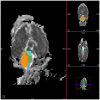Can cerebellar and brainstem apparent diffusion coefficient (ADC) values predict neuromotor outcome in term neonates with hypoxic-ischemic encephalopathy (HIE) treated with hypothermia?
- PMID: 28686592
- PMCID: PMC5501430
- DOI: 10.1371/journal.pone.0178510
Can cerebellar and brainstem apparent diffusion coefficient (ADC) values predict neuromotor outcome in term neonates with hypoxic-ischemic encephalopathy (HIE) treated with hypothermia?
Abstract
Background and purpose: To determine the apparent diffusion coefficient (ADC) in specific infratentorial brain structures during the first week of life and its relation with neuromotor outcome for Hypoxic-ischemic encephalopathy (HIE) in term neonates with and without whole-body hypothermia (TH).
Materials and methods: We retrospectively evaluated 45 MRI studies performed in the first week of life of term neonates born between 2010 and 2013 at Boston Children's Hospital. Selected cases were classified into three groups: 1) HIE neonates who underwent TH, 2) HIE normothermics (TN), and 3) controls. The neuromotor outcome was categorized as normal, abnormal and death. The ADCmean was calculated for six infratentorial brain regions.
Results: A total of 45 infants were included: 28 HIE TH treated, 8 HIE TN, and 9 controls. The mean gestational age was 39 weeks; 57.8% were male; 11.1% were non-survivors. The median age at MRI was 3 days (interquartile range, 1-4 days). A statistically significant relationship was shown between motor outcome or death and the ADCmean in the vermis (P = 0.002), cerebellar left hemisphere (P = 0.002), midbrain (P = 0.009), pons (P = 0.014) and medulla (P = 0.005). In patients treated with TH, the ADC mean remained significantly lower than that in the controls only in the hemispheres (P = 0.01). In comparison with abnormal motor outcome, ADCmean was lowest in the left hemisphere (P = 0.003), vermis (P = 0.003), pons (P = 0.0036) and medulla (P = 0.008) in case of death.
Conclusion: ADCmean values during the first week of life in the left hemisphere, vermis, pons and medulla are related to motor outcome or death in infants with HIE either with or without hypothermic therapy. Therefore, this objective tool can be assessed prospectively to determine if it can be used to establish prognosis in the first week of life, particularly in severe cases of HIE.
Conflict of interest statement
Figures

Similar articles
-
Prognostic Value of the Apparent Diffusion Coefficient in Newborns with Hypoxic-Ischaemic Encephalopathy Treated with Therapeutic Hypothermia.Neonatology. 2017;112(1):67-72. doi: 10.1159/000456707. Epub 2017 Mar 29. Neonatology. 2017. PMID: 28351039
-
Diffusion Tensor Imaging Detects Occult Cerebellar Injury in Severe Neonatal Hypoxic-Ischemic Encephalopathy.Dev Neurosci. 2017;39(1-4):207-214. doi: 10.1159/000454856. Epub 2017 Jan 18. Dev Neurosci. 2017. PMID: 28095379 Free PMC article.
-
Cerebellar injury in term neonates with hypoxic-ischemic encephalopathy is underestimated.Pediatr Res. 2021 Apr;89(5):1171-1178. doi: 10.1038/s41390-020-01173-z. Epub 2020 Sep 23. Pediatr Res. 2021. PMID: 32967002
-
Therapeutic hypothermia for neonates with hypoxic ischemic encephalopathy.Pediatr Neonatol. 2017 Dec;58(6):475-483. doi: 10.1016/j.pedneo.2016.11.001. Epub 2017 Mar 27. Pediatr Neonatol. 2017. PMID: 28416250 Review.
-
Outcomes in childhood following therapeutic hypothermia for neonatal hypoxic-ischemic encephalopathy (HIE).Semin Perinatol. 2016 Dec;40(8):549-555. doi: 10.1053/j.semperi.2016.09.007. Epub 2016 Nov 15. Semin Perinatol. 2016. PMID: 27863707 Free PMC article. Review.
Cited by
-
Cerebral Autoregulation and Conventional and Diffusion Tensor Imaging Magnetic Resonance Imaging in Neonatal Hypoxic-Ischemic Encephalopathy.Pediatr Neurol. 2018 May;82:36-43. doi: 10.1016/j.pediatrneurol.2018.02.004. Epub 2018 Apr 2. Pediatr Neurol. 2018. PMID: 29622488 Free PMC article.
-
Prenatal neural origins of infant motor development: Associations between fetal brain and infant motor development.Dev Psychopathol. 2018 Aug;30(3):763-772. doi: 10.1017/S095457941800072X. Dev Psychopathol. 2018. PMID: 30068433 Free PMC article.
-
Development of Brain Networks In Utero: Relevance for Common Neural Disorders.Biol Psychiatry. 2020 Jul 1;88(1):40-50. doi: 10.1016/j.biopsych.2020.02.007. Epub 2020 Feb 19. Biol Psychiatry. 2020. PMID: 32305217 Free PMC article. Review.
-
Cerebellar growth, volume and diffusivity in children cooled for neonatal encephalopathy without cerebral palsy.Sci Rep. 2023 Sep 8;13(1):14869. doi: 10.1038/s41598-023-41838-3. Sci Rep. 2023. PMID: 37684324 Free PMC article.
-
Cerebral Perfusion Is Perturbed by Preterm Birth and Brain Injury.AJNR Am J Neuroradiol. 2018 Jul;39(7):1330-1335. doi: 10.3174/ajnr.A5669. Epub 2018 May 10. AJNR Am J Neuroradiol. 2018. PMID: 29748205 Free PMC article.
References
-
- Levene MI, Sands C, Grindulis H, Moore JR. Comparison of two methods of predicting outcome in perinatal asphyxia. Lancet. 1986; 1(8472): 67–9. - PubMed
-
- García-Alix A, Martínez-Biarge M, Diez J, Gayá F, Quero J. Neonatal hypoxic-ischemic encephalopathy: Incidence and prevalence in the first decade of the 21st century. An Pediatr (Barc). 2009; 71:319–26. - PubMed
-
- Vannucci RC. Current and potentially new management strategies for perinatal hypoxic-ischemic encephalopathy. Pediatrics. 1990; 85:961–68. - PubMed
-
- Gluckman PD, Wyatt JS, Azzopardi D, Ballard R, Edwards AD, Ferriero DM, et al. Selective head cooling with mild systemic hypothermia after neonatal encephalopathy: multicentre randomised trial. Lancet. 2005; 365(9460): 663e70. - PubMed
-
- Shankaran S, Laptook AR, Ehrenkranz RA, Tyson JE, McDonald SA, Donovan EF, et al. National Institute of Child Health and Human Development Neonatal Research Network. Whole-body hypothermia for neonates with hypoxic-ischemic encephalopathy. N Engl J Med. 2005; 353(15): 1574–84. - PubMed
MeSH terms
Grants and funding
LinkOut - more resources
Full Text Sources
Other Literature Sources

